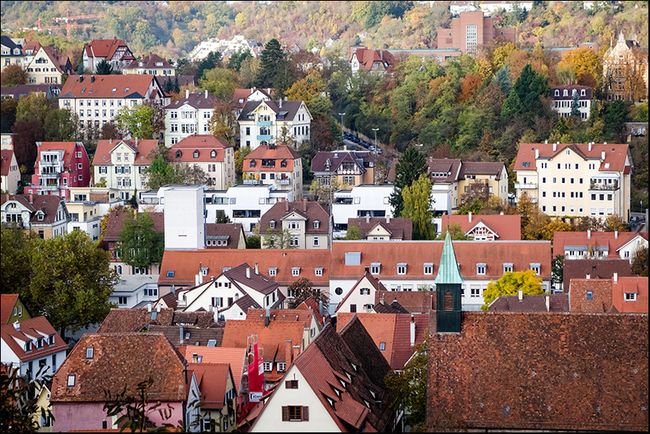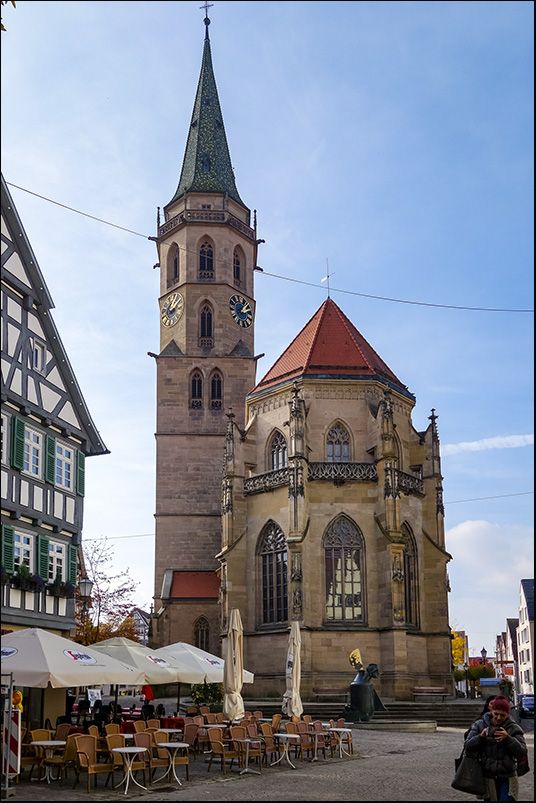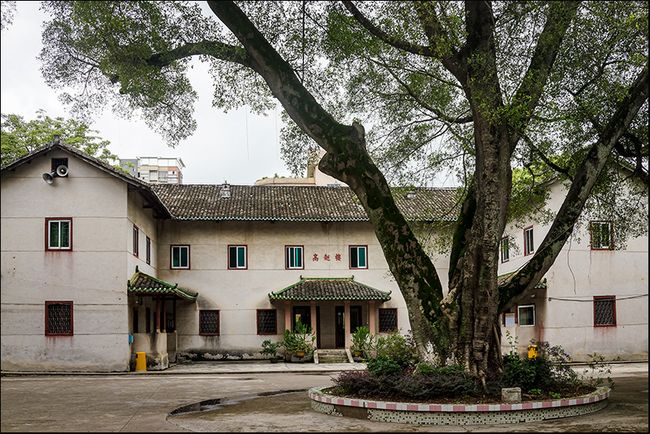The Hakka Story of a German Father and Son
图/文: HEPING & OU
1
November 2016, Schorndorf, a small town to the east of Stuttgart, Germany.
When we set off for the university town of Tübingen, the fields beside the road were swathed in mist, but by the time we reached Tübingen the sun was shining from a blue sky. It was late autumn, a season when the River Neckar flows gently through its valley. Reflecting the red, yellow and golden leaves, its water was a riot of colours.
This was our second visit. When we had driven past the campus two years before, it had made an indelible impression on us. At that time, however, we could hardly have imagined that Tübingen would in any way be linked with Meizhou, a remote place in Guangdong Province, China.
11月,德国,绍恩多夫(Schorndorf),斯图加特东面不远的一个小城。
我们从这个小城出发去大学城蒂宾根的时候,公路两边的田野薄雾弥漫。
待到蒂宾根时,却忽然阳光普照,蓝天白云。
深秋时节,山谷里的内卡河缓缓流动,两岸的树林染上了红、黄、金的颜色,河面上流光溢彩。
这是我们第二次来蒂宾根,第一次是两年前,在这里匆匆而过,但美丽的大学城给我留下难忘的印象。
但我们从来没有想到,这里和“远在天边”的广东梅州会有什么关系。
Our guide was an 80-year-old German, Klaus Autenrieth. Toour ears, his Chinese name, Hao Junhe(豪俊和), sounded rather affectionate. Hao Junhe was born in Tübingen in 1936. When he was a mere 10 months old his parents brought him all the way from Germany to Kaying, now Meizhou, in the east of Guangdong Province, and he spent his childhood in the mountainous Hakka areas of Meizhou.It was not until 1947, when he was already 11, that he would return to Germany.。
带我们从绍恩多夫去蒂宾根的,是80岁的德国老人Klaus Autenrieth。他有一个听起来感觉更为亲切的中文名,叫豪俊和。
豪俊和1936年在蒂宾根出生,但他的少年时期几乎都在广东梅州的客家山区度过。
他只有10个月大的时候,1936年,其父母就带着他,万里迢迢,来到中国粤东的一个叫“嘉应”(现为梅州)的地方。直到1947年,11岁时他才离开梅州回到德国。
2
Hao Junhe’s father, who was known as Hao Tianli(豪天立), was in fact a clergyman named Georg Emil Autenrieth. Hao Junhe told us that the Chinese name of his father was, in fact, how his German surname sounded in Chinese. In 1926, at the age of 26, he was sent to China for the first time by the Basler Mission based in Switzerland.
豪俊和的父亲豪天立(Georg Emil Autenrieth)是一名牧师,豪俊和说,他父亲豪天立这个中文名,其实就是他的德文姓的音译。他毕业于瑞士巴色会神学院,1926年,他受瑞士巴塞尔差传会(Die Basler Mission)派遣,第一次到中国的时候,只是一个26岁的青年牧师。
In Meizhou, he taught German and English at Le Yu Secondary School and the local campus of Sun Yat-sen University. He also studied Chinese culture, and spoke the Hakka dialect with the local residents and students. In the room at the school where the annals are kept there are still some archive materials about Hao Tianli, including photographs.
Hao Tianli did not return to Germany until 1947, after 21 years living in China. His former students in Le Yu Secondary School included doctors, professors andother academicians, and even ministers.
在粤东梅州,豪天立同时在当地的乐育中学(还有中山大学分校)教授德语和英语。他在那里深入学习中国文化,能够与最普通的民众和学生用客家话交流。现在梅州乐育中学的校史室里,还有他任教的记录和照片。
豪天立直到1947才离开中国返回德国,在中国前后整整生活了21年。他在梅州乐育中学教过的客家子弟,有不少成为博士、教授,有些后来甚至成为国家的部长和工程院院士。
3
In fact, from the end of the 19th century until the 1950s, over one hundred German and Swiss lived in the mountainous Hakka areas of Meizhou. They worked as priests, teachers, doctors,nurses and charity workers. As well as chapels, they set up schools, hospitals and welfare houses. In Meizhou, we were surprised to learn that the first seven headmasters of Le Yu Secondary School and the first ten presidents of Deji Hospital, now Meizhou Municipal People’s Hospital, were all either German or Swiss. However, this historical fact has been largely forgotten.
实际上,从十九世纪末到二十世纪四十年代,先后有一百多位德国人和瑞士人曾在梅州一带的客家山区工作和生活过,他们是牧师、老师、医生、护士和福利院的工作人员。除了教会之外,他们还办起了学校、医院和福利院。
在广东省的梅州市,我们意外地发现,建于1902年的梅州乐育中学的前七任校长,建于1896年的德济医院(今梅州市人民医院)的前十任院长,都是德国人和瑞士人。这是一段几乎被遗忘的历史。
In the early 20thcentury, Meizhou remained a poor and remote backwater. Yet to our utter surprise, the schools and hospitals in the mountainous Hakka areas were the first places in China toreceive western education and western medicine. Born and bred in the Hakka mountains, the German and Swiss descendants became Hakka Europeans, and the Hakka language was their second native tongue. Hao Junhe was one such descendant. Thanks probably to his upbringing and love of China,he returned to China from 1965 to 1967 in order to study Hakka and Cantonese in Hong Kong. It was no surprise that when we met him in November 2016 he was still speaking fluent Hakka.
在十九世纪末,二十世纪初,不是在那些繁华都市,沿海口岸,而是在比较贫穷和落后的嘉应(梅州),客家山区的学校和医院,无疑是中国最早和西方现代教育和医疗体系接轨的地方之一。古老的嘉应州,曾经有过如此深入的中西文明与文化的交流,这令我们颇感惊讶。
这些德国人和瑞士人在那里工作和生活,有些长达几十年之久,他们的孩子,在客家山区出生,喝客家山区的水长大。他们是来自于欧洲的“客家人”,客家话在一定程度上成为他们的第二“母语”。豪俊和就是这些孩子中的一个。他兄弟姐妹六人,除了他在德国出生外,其他都在中国出生,他们一家在梅州地区五华的梅林、兴宁的坪塘和梅县都生活过。
也许是受少年生活经历影响以及对中国的热爱,1965-1967年,豪俊和再次返回中国,在香港学习客家话和粤语。所以,我们今天在德国见到的豪先生,能讲一口地道的客家话,就一点都不奇怪了。
4
Hao drove us to his native Tübingen, where he studied for his degree. Situated to the south of Stuttgart by the clear Neckar river it is a famous German university town, at once traditional and modern in character.Thanks to the university the town is fondly known as ‘the republic of scholars’. With over 500 years of history, the university includes among its notable alumni the astronomer Kepler, the philosophers Hegel and Schelling, and the poets Hölderlin and Uhland.
豪先生开着他的帕萨特旅行版小车带我们去蒂宾根,那是他出生和读大学的地方。它位于斯图加特西南方,坐落在山清水秀的内卡河畔,是德国有名的大学城,是一个既古典又现代的城市。
The University of Tübingen is built on a hill, but certain of its faculties such as Protestant Theology, Catholic Theology, Law, Economics and Social Science, and Medicine are located throughout the town. From the hill one can watch students rowing their boats on the Neckar in a scene which is reminiscent of Cambridge.
蒂宾根有个别致的雅号,叫蒂宾根大学“学者共和国”。全市8万人口中3万多人,几乎家家户户都与大学有关系。人们说,蒂宾根没有大学,它本身就是一座大学。
这座大学已有500多年的历史。有意思的是,豪天立父子,和哲学家黑格尔、谢林,诗人荷尔德林等,都毕业于蒂宾根大学的新教神学院。
大学依山而建,它的新教神学院,天主教神学院,法学院,经济学院,理论医学学院,临床医学学院,哲学学院等学院分布在小城的不同地方。
从山坡往下看,可以看到内卡河上学生划的小艇,那情景有点像英国的剑桥。
我们跟着豪先生上坡下坡,步行过内卡河大桥,从河边的小路上山。
After crossing the Neckar bridge and walking along the river we followed Hao into the mountains. Whether on the high street or on the unevengranite path to the castle, Hao walked swiftly two or three metres ahead of us, showing no sign of his age.The castleon the hilltop is now a university museum, giving a clear view of the town in the valley. Hao observed that it was quite a while since his last visit, and the town has changed significantly. He vividly remembered his student hall of residence, and tried to use his camera to retrace his student life.
无论走在街头,还是凹凸不平的方块石城堡道上,豪俊和一点不像80岁的老人,迈着矫健的步子,总是把我们甩在他身后约两三米远。
山顶的城堡,现在是蒂宾根大学的一个博物馆,可以看到山谷里地城市。
豪先生说他也有一段时间没来这里了,变化很大。他拿起相机拍照,寻找他学生时代的足迹。他依然记得他住过的那间学生宿舍。
5
Hao Junhe’s interestin China remains.He still reads the overseas edition of the People’s Daily in his attic study. The archive materials, both German and Chinese, which his father brought back from China, are intact in their tidy categories. Hao has fond memories of his childhood in Meizhou. Since the 1980s he has returned no fewer than16 times, not only with his wife, but also leading parties of students when he was headmaster of a secondary school. In his conversations with us, he would every now and then mix English with some Hakka.In a television interview in Meizhou, he surprised viewers by speaking in a style of Hakka that was somewhat archaic.
多年来,豪俊和保持对中国的关注和兴趣。直到如今,他在阁楼上的书房里,仍每天都读人民日报的海外版。对他父亲从中国带回来的资料,无论是德文的还是中文的,他都分门别类地保存得完完整整,有一种德国式的严谨。
对他童年生活过的梅州,他一往情深,自1986年直到2014年,先后一共回去了十五次。不但他自己和太太,兄弟,女儿一起回去,以及那些曾在梅州生活过的当年的小朋友,在他担任一所中学校长的时候,他还带着一群德国中学生一起回梅州,和他父亲工作过的乐育中学的学生们进行交流。他在德国组织了一个“德中友谊促进会”,担任会长,组织了大大小小的各类推介中国文化的活动。
豪先生在用英语交流中,时不时,总会冒出几句客家话,他说他回梅州,电视台给他拍片做访问时,很惊讶这个德国老人居然可以讲上个世纪地道的客家话。
In November 1984 the Alumni Association of the Le Yu Secondary School elected his father Hao Tianli as its honorary president. Unfortunately,Hao Tianli had died only the previous year. He is buried in his native Weilheim, whence he had first set off for China many decades before.
1984年11月,广东省梅州市乐育中学校友会发出荣誉聘书,推选豪天立为校友会的名誉会长。可惜的是,这是一份迟到的聘书,豪天立先生已于1983年去世,并长眠于他出生,并且从这里远赴中国的德国小城魏尔海姆。
Hao took us to see his father’s tomb in Weilheim. In the tranquil graveyard, and by the side of a dark green conifer, was an unusual tombstone carved in Chinese. It bears the intriguing inscription: I AM THE LIFE.
在魏尔海姆的一个墓园,豪先生带我们去看他父亲的墓。在一棵墨绿色的柏树旁边,立着一个与众不同的由中文书写的墓碑。
墓碑上留下一句发人深省的话:
我就是生命。
(English translated by Laura & Andrew, 2017.1)





















